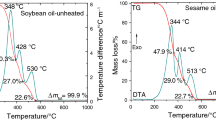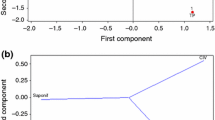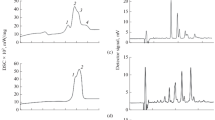Summary
Eighty-four samples of soybean oils, representing various types of processing and different refining procedures, have been examined spectrophotometrically and the spectral-transmissive curves for 35 of them are reproduced in this communication. The spectral-transmissive properties of these oils have been discussed with particular reference to the effect which variations in processing have on these properties.
In the light of the results obtained in these studies it is apparent that: (1) The spectral-transmissive properties of soybean oils are influenced by the method used in removing the oil from the bean as well as by subsequent processing procedures; (2) the Lovibond color readings give at best only approximate information concerning the spectral color of an oil; and (3) the carotenoids are removed during refining operations, the greatest loss usually occurring during the deodorizing treatment. Chlorophyll, which is present in various concentrations in the crude oil, is completely absent from the finished oil so far as spectrophotometric evidence is concerned.
Similar content being viewed by others
Bibliography
Priest, Irwin G. The Color of Soya Bean Oil as Compared with that of Cottonseed Oil. The Cotton Oil Press,3 (No. 9), 37 (1919–20).
Wesson, David. Progress Report of Color of Oil and Meal Committee. The Cotton Oil Press,6 (No. 5), 33–37 (1922).
McNicholas, H. J. The Color and Spectral Transmittance of Vegetable Oils. Oil and Soap,12, 167–178 (1935); cf. J. Res. Nat’l. Bur. of Stds.,15, 99–121 (1935).
McNicholas, H. J. Idem, 100, footnote 4.
McNicholas, H. J. Idem, 103.
Zscheile, Jr. F. Paul. An Improved Method for the Purification of Chlorophylls A and B; Quantitative Measurement of Their Absorption Spectra; Evidence for the Existence of a Third Component of Chlorophyll. The Bot. Gaz.,95, 529–562 (1933–34).
Dollear, F. G., Krauczunas, P., and Markley, K. S. The Chemical Composition of Some High Iodine Number Soybean Oils. Oil and Soap,17, 120–1 (1940).
Coe, M. R. Photochemical Studies of Rancidity: The Mechanism of Rancidification. Oil and Soap,15, 230–236 (1938).
Kraybill, H. R., Brewer, P. H., and Thornton, M. H. U. S. Patent No. 2,174,177 (September 26, 1939).
Author information
Authors and Affiliations
Additional information
A cooperative organization participated in by the Bureaus of Agricultural Chemistry and Engineering and Plant Industry of the U. S. Department of Agriculture and the Agricultural Experiment Stations of the North Central States of Illinois, Indiana. Iowa, Kansas, Michigan, Minnesota, Missouri, Nebraska, North Dakota, Ohio, South Dakota, and Wisconsin.
About this article
Cite this article
Bickford, W.G., Anderson, S. & Markley, K.S. The stability of vegetable oils. Oil Soap 17, 138–143 (1940). https://doi.org/10.1007/BF02593109
Issue Date:
DOI: https://doi.org/10.1007/BF02593109




